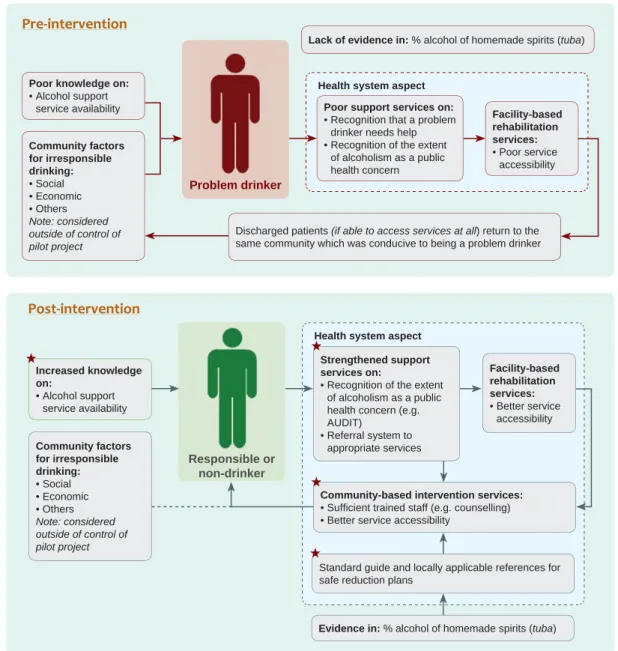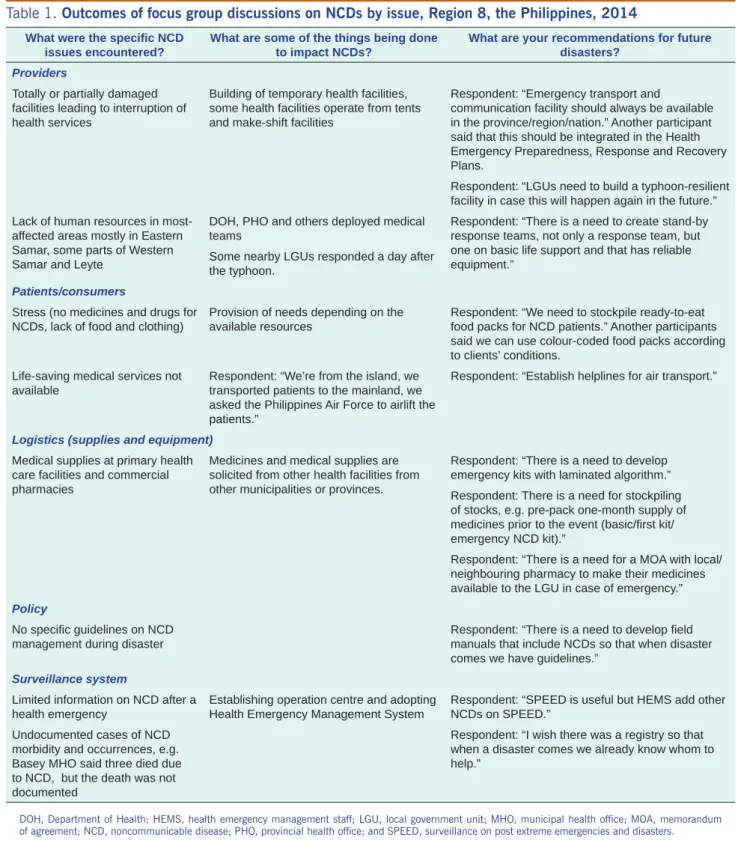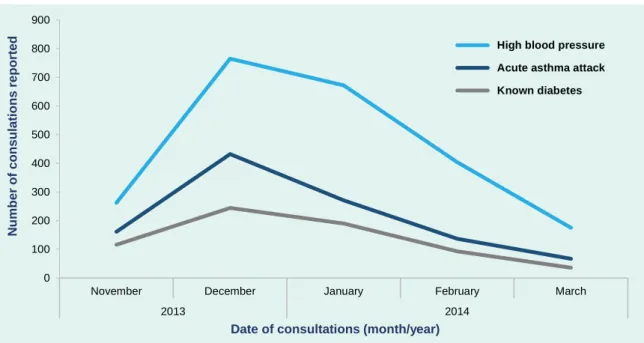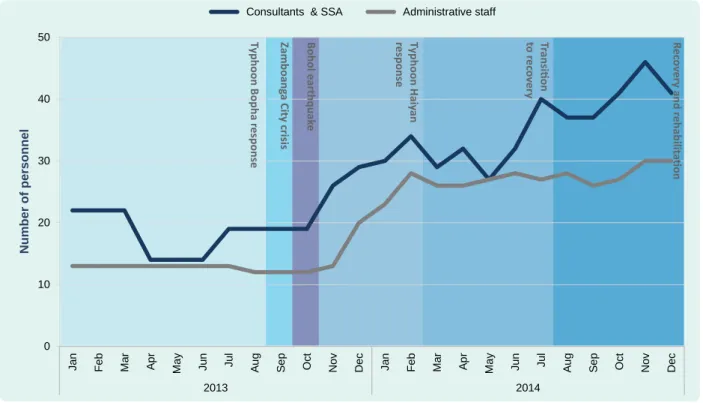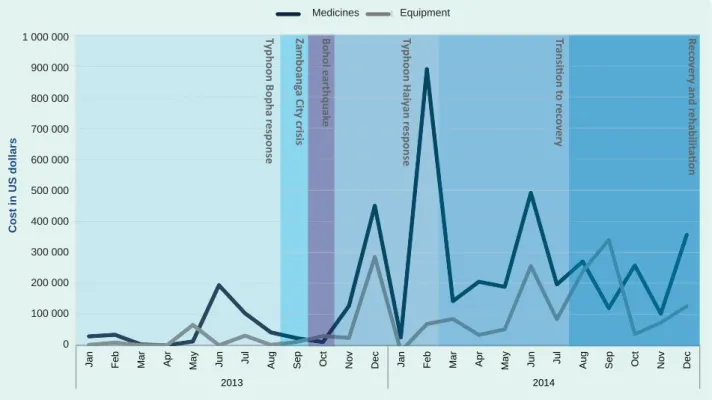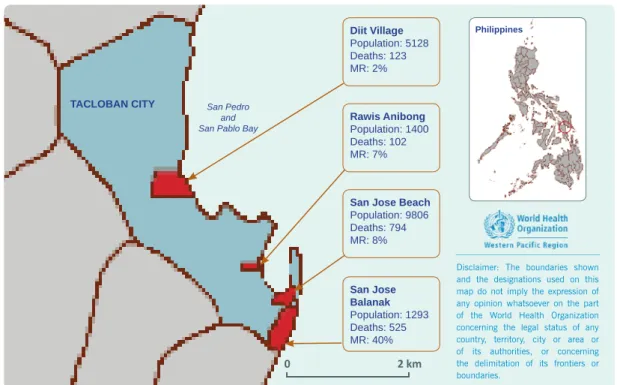This cross-section of articles provides many observations and lessons learned from the health response to Typhoon Haiyan in the Philippines. An evaluation of the incident notification system 16 months after Typhoon Haiyan in Region 8, Philippines.
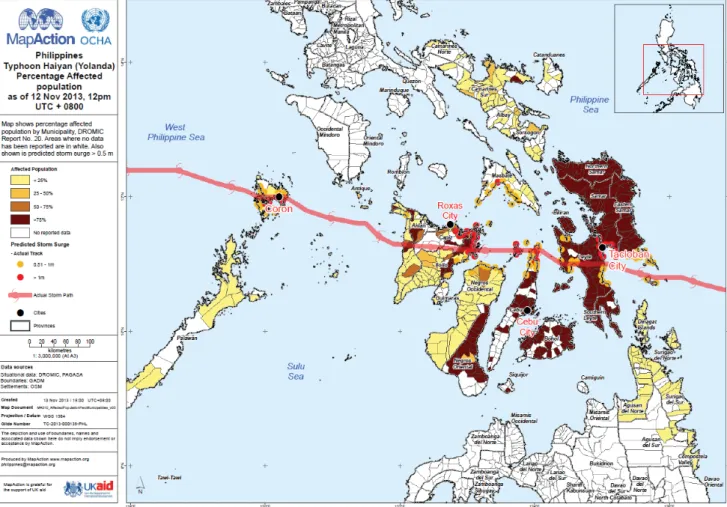
DISCUSSION
While more high-fatality events were associated with low-income countries compared to high-income countries (87,208 cumulative deaths in high-income countries compared with 243,334 in low-income countries), there were fewer publications for events in low-income countries. At the time of the earthquake, there were many international humanitarian workers and 276 publications; the secondary cholera outbreak had 21 publications.
RESULTS
The degree of investment from high-income countries to support response efforts in low-income country events may also influence authorship affiliation. For events in low-income countries – external international support is time-limited and teams leaving the country must report on their input to the government and other donors.
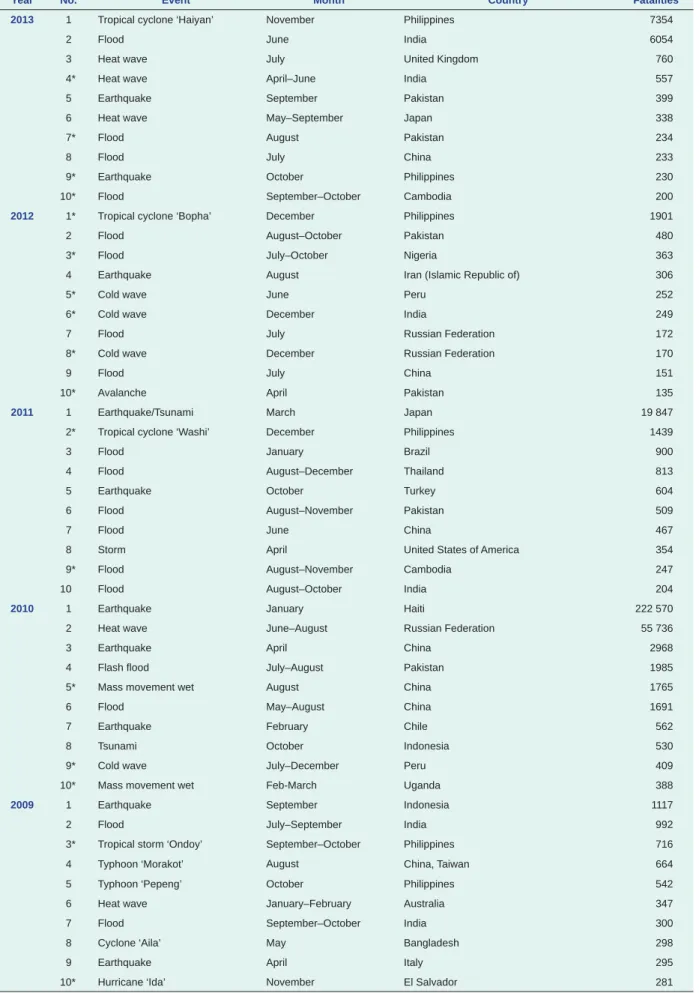
DEVELOPMENT OF MATERNAL AND NEWBORN GUIDELINES
As a result, the Guidelines for Maternal and Newborn Care During Childbirth, Immediate Newborn Care and Postnatal Care in Emergencies and Disasters4 were developed. This brief report describes the guidelines and post-Haiyan training program for the Essential Intrapartum and Newborn Care (EINC) protocol and Kangaroo Mother Care (KMC) components.
CONCLUSION
One of the observed benefits of the KMC program after Haiyan was the increased involvement of fathers. These assessed the use of the PEN protocols, the availability of PEN implementation tools and whether the implementation targets for Region 8 had been met.
TRAINING AND MATERIALS
After Haiyan, PEN implementation in primary health care facilities became a priority, with Region 8 selected as a pilot site for using PEN implementation for post-disaster health system recovery. Monitoring visits that included supportive surveillance were also conducted in primary health care facilities in six counties in Region 8.
PEN INDICATORS
MONITORING VISITS
Burial
Each trench was at least 1.5 meters deep, and the bodies were buried individually in the trenches.
Data storage, analysis and dissemination The data from the forms were entered on to a database
Processing the dead bodies
As a result of multiple agencies working together to manage the dead after Typhoon Haiyan, there was a lack of a common database or identification algorithm. Introduction: Access to safe drinking water is one of the most important public health issues in emergencies. Methods: Water quality testing and risk assessments of drinking water systems were conducted three weeks and 10 months after Haiyan.
Access to safe drinking water is one of the most important public health concerns in emergency situations. Corrective actions for the risks were provided on the form and feedback was provided to water supply system operators to address the risks. Rehabilitation services were limited in the area of the Philippines affected by Typhoon Haiyan.
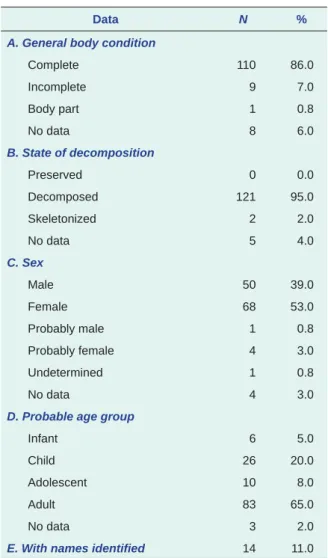
INITIAL REHABILITATION NEEDS ASSESSMENT AND ACUTE RESPONSE
Benigno et al Post-Haiyan response for the disabled .. four temporary field hospitals), evacuation centers and selected municipalities (Alang-Alang, Babatngon, Palo, Pastrana, Sta Fe, Tacloban City, Tanauan and Tolosa) in Leyte Province, Region 8 between November 9, 2013 and April 30, 2014 by HI through a grant agreement with the World Health Organization using the Individual Rehabilitation Assessment Form (Figure 1) and rehabilitation specialists of tertiary hospitals in Tacloban City. People with injuries and disabilities were assessed according to their physical, sensory and cognitive problems and functional limitations in performing daily life activities such as eating, drinking, dressing, bathing, toileting, moving, communicating and playing with children. Almost 400 aids, including 50 prostheses and 320 mobility aids (133 canes, 98 crutches, 50 walkers and 39 wheelchairs), were provided to people with new injuries or pre-existing disabilities.
Region 8, the area most affected by Typhoon Haiyan, had 13,478 low-income households in which people with disabilities lived.8 After Typhoon Haiyan in November 2013, all six hospitals in Tacloban City, the capital of the Leyte province, which previously offered rehabilitation. services are destroyed. Immediately after Haiyan, all services, including rehabilitation services for people with disabilities and injuries, ceased at both inpatient and outpatient facilities. In this paper we describe the needs assessments and the activities carried out to increase access to rehabilitation and other services for people with disabilities and with injuries.
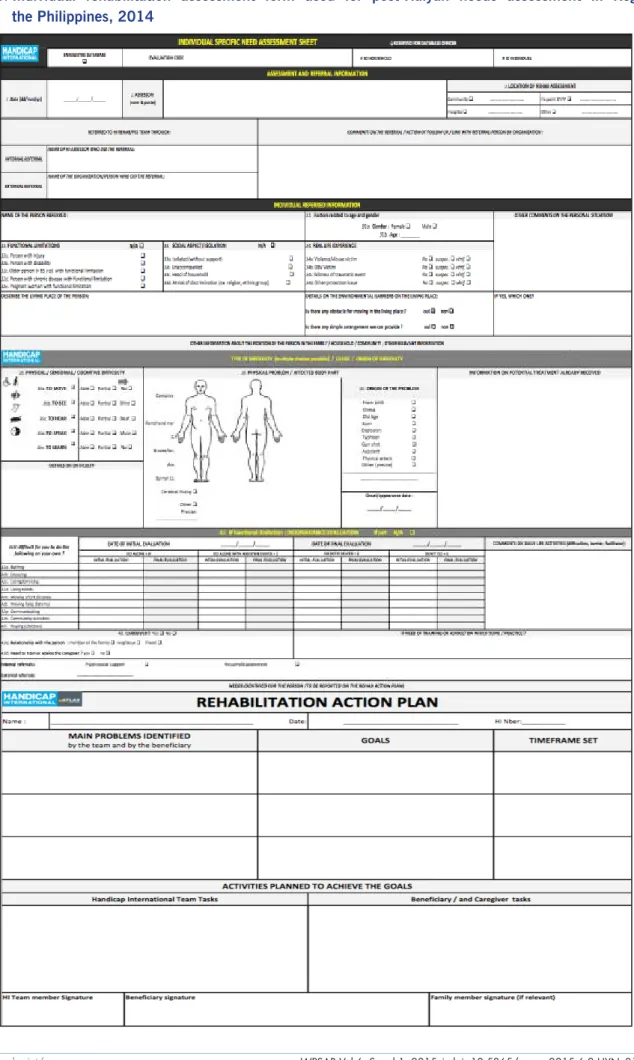
STRENGTHENING DISABILITY REFERRAL SYSTEM
The WHO Representative Office in the Philippines contributed to the improvement of rehabilitation medicine by purchasing rehabilitation equipment (eg therapeutic ultrasound, resistance exercise products and motor and dexterity activity sets). As a result of these improvements, the regional hospital provided rehabilitation to more patients, including those in critical care units, for a wider range of musculoskeletal and neurological conditions. The number of patients receiving rehabilitation at the regional hospital increased from 533 patients a year before Haiyan to 1,547 in 2014.
IMPROVING DELIVERY OF
REHABILITATION SERVICES IN THE REGIONAL HOSPITAL
At the national level, NCDA has produced and disseminated two advocacy documents promoting consultation and inclusion of persons with disabilities in reconstruction efforts. The poster advocating information, empowerment and respect for disabled people was the most reproduced poster. With all this information in one directory, people with disabilities had better access to information about various services and programs.
Community-based rehabilitation initiative Community-based rehabilitation (CBR) is a programmatic approach to increase awareness and inclusion of persons with disabilities at the community level and has been implemented by the local government with the support of WHO. This study also found that detailed pre-disaster data was limited and that having assessments and profiles of people with disabilities in communities before a disaster would improve the response. Efforts to increase referral for the PWD Identification Card in the Philippines are currently being conducted through active identification through the PDAO office and through CBR referral efforts by Barangay Health Workers of Tacloban City;11 this would be a way to identify persons disabled after the disaster.
CONCLUSIONS
This study assessed the functionality of the three disease surveillance systems used after Haiyan: Philippine Integrated Disease Surveillance and Response (PIDSR), Event-based Surveillance and Response (ESR), and Surveillance in Post Extreme Emergencies and Disasters (SPEED). Most of the monitoring units judged PIDSR, ESR and SPEED to be complementary to each other. The operation of the three disease surveillance systems varied after Haiyan by region and province/cities (Table 1).
Of the remaining nine monitoring units, eight (89%) had SPEED operational within one week of Haiyan, and one (11%) was operational within seven weeks (Leyte). This study shows that in most of the monitoring units in the areas affected by Typhoon Haiyan, the routine monitoring systems (PIDSR and ESR) were not disturbed. Core functions of the case notification system of ESUs and on-call hospitals, 16 months after Haiyan in Region 8, Philippines, March 2015 (n = 9).
Introduction: This paper provides a snapshot of health care costs, out-of-pocket costs and available safety nets following Typhoon Haiyan. The impact of the disaster on the medication management system could not be quantified.
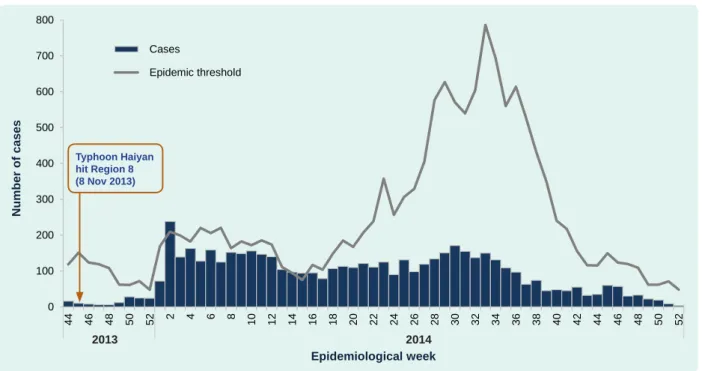
PROBLEM
CONTEXT
To assess the impact of these social media platforms, the monthly number of followers and posts were obtained from Facebook and Twitter accounts between November 27, 2013 and January 30, 2015. The Facebook account was prioritized as it had more users in the Philippines, especially in rural areas, compared to other social media. Twitter accounted for only 40% of social media users in the rural population.6 There was an increase in the number of followers on both Facebook and Twitter, although this was more significant for Facebook (Figure 1).
According to WHO policy, all social media posts and followers must be generated organically. This policy posed a major challenge for the social media team, as it had to rely on followers actively searching for WHO's social media pages, which were being created for the first time, rather than using mechanisms where content posted on social media accounts. In July 2014, Typhoon Glenda made landfall in Manila, and so the content of social media messages after Haiyan included preparation Recently, social media has played a role.
ACTION
WHO was only able to evaluate the social media campaign using the number of views and likes from social media posts. Another important lesson was that a social media presence should be established during non-emergency periods. Since each partner has different priorities, different aspects of the response are emphasized through social media.
Social media outputs were also reported, some of which were shared with partners such as UNICEF and the Department of Health, for example promoting breastfeeding in disasters. The social media team was able to track the performance of each post through the Facebook analytics tool, which helped identify the type of content that achieved the greatest reach. Traditional media reported on the social media campaign with the health priorities in the affected areas six months after the typhoon.
LESSONS LEARNT
During daily meetings, the needs of those in the affected areas were discussed along with the activities being undertaken. Within the first week of the campaign, 170 entries were distributed to all WHO hubs in the Typhoon Haiyan affected regions. Social media was used for the first time by WHO in the Philippines as part of the ERC strategy in the response to Typhoon Haiyan.
All TB services in the affected areas (473 DOTS, 490 TB microscopes and six PMDT facilities) were restored just two months after Haiyan. About two-thirds of the health infrastructure in the affected regions was not functioning one week after the typhoon struck (Table 1). Although it took time to establish normal delivery and distribution of anti-tuberculosis drugs, there was no shortage of drugs in the affected areas.
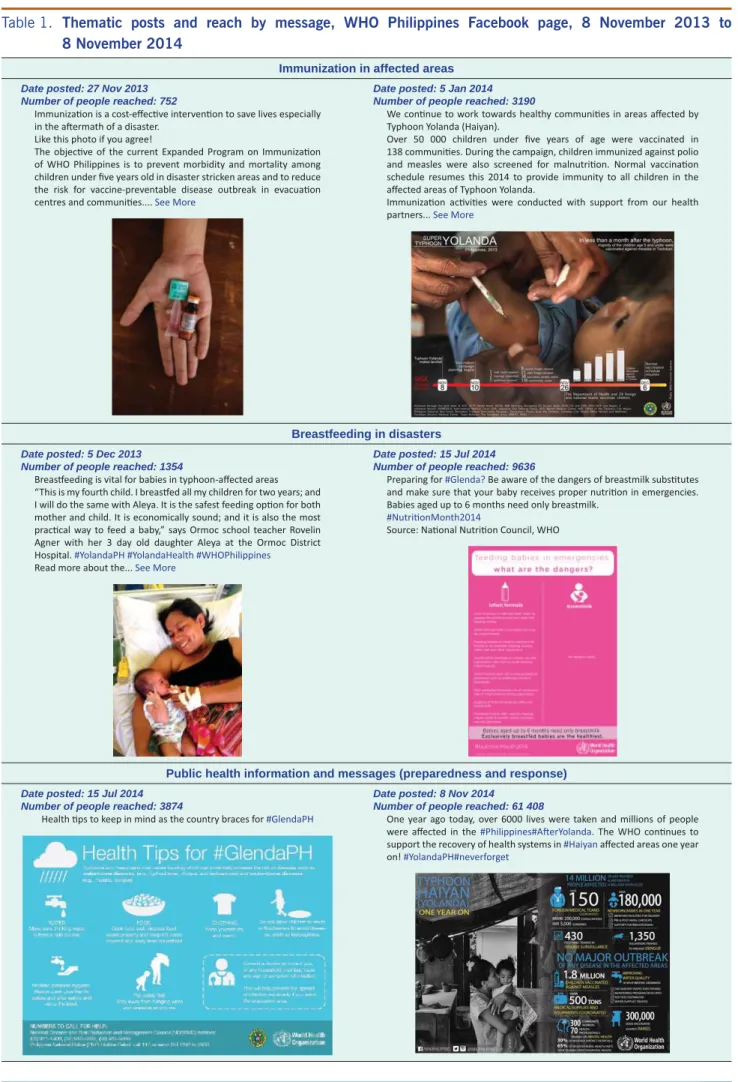
OUTCOME
Context: Tacloban City is a highly urbanized city that was one of the areas most affected by Typhoon Haiyan. Action: A pilot community alcohol assistance program was implemented which included: an assessment of the extent of alcohol problems in the community and the basic knowledge and skills of health workers; training health professionals on providing assistance in alcohol treatment in primary care; and community outreach through post-training supervision. As part of the response to Typhoon Haiyan in November 2013, the World Health Organization (WHO) and the Department of Health (DOH) and other key stakeholders implemented the Mental Health Action Program (mhGAP).9 As part of this mental health, the WHO Representative Office in the Philippines is in Tacloban, one of the areas worst affected by Typhoon Haiyan, piloted a community-based alcohol assistance program to identify the extent of alcohol-related problems and train local health personnel to provide alcohol-based intervention services.
Respondents were from 39 of the 138 villages in Tacloban City and were more likely to be members of the urban poor with little or no access to alcohol intervention services within their practical reach. One of the villages most affected by Haiyan on the outskirts of Tacloban City was selected for contact. We do not know if the level of alcohol use reported in this study is indicative of the level before Typhoon Haiyan or if it was an increase.
